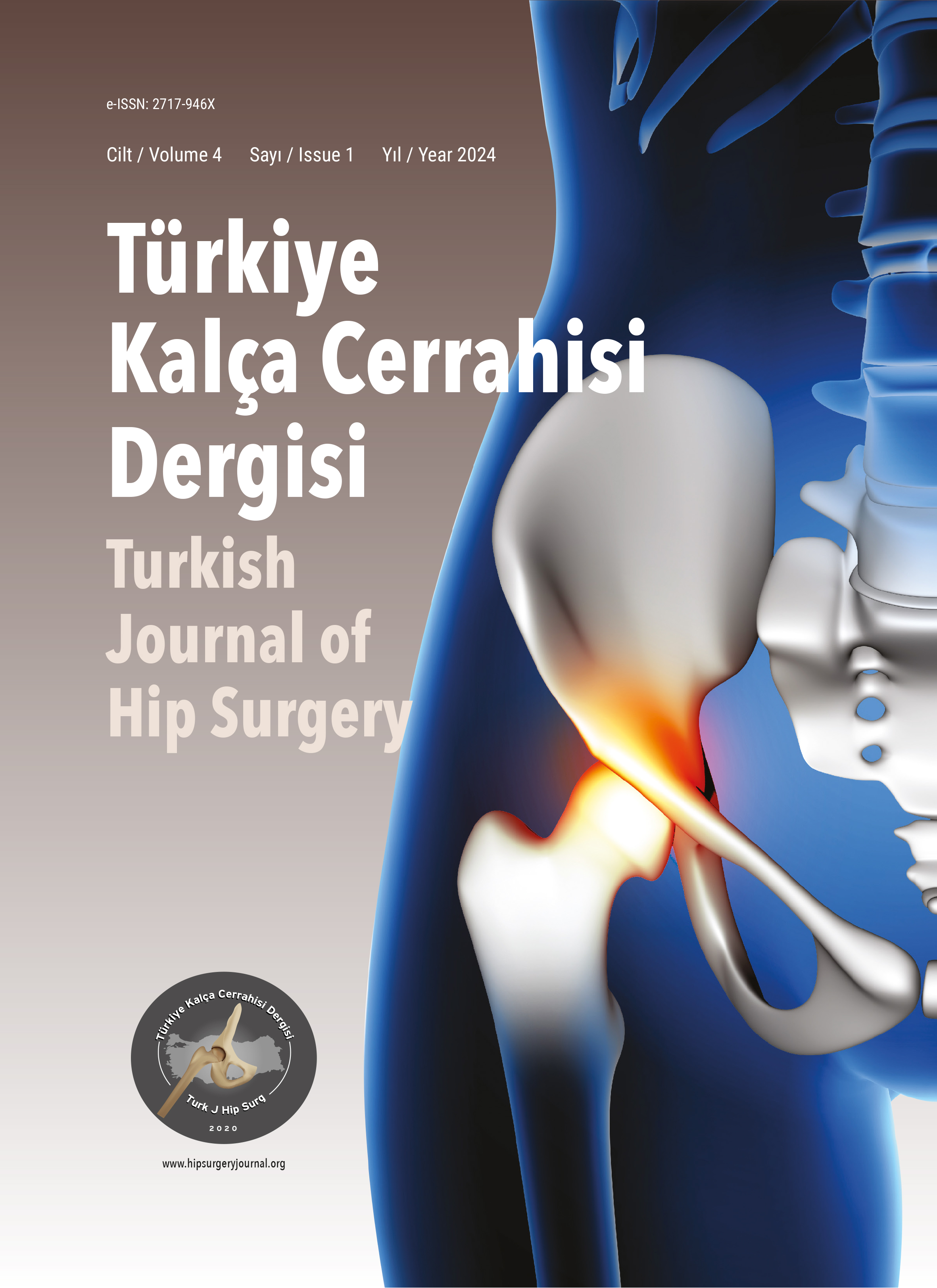
Effect of Lumbar Variables on Acetabular Version: Analysis with Pelvic-CT Scan
Yüksel Uğur Yaradılmış, Alparslan Kılıç, Ali Teoman Evren, Mehmet Ali Tokgöz, Hakan Şeşen, Murat AltayDepartment of Orthopaedics and Traumatology, University of Health Sciences, Keçiören Health Practice and Research Center Ankara, TurkeyABSTRACT
Objective: The acetabular version is important both for the diagnosis of hip pathologies and in hip replacement surgery. This study aimed to present the acetabular version of the Turkish population and to determine the variation of the acetabular version according to pelvic and lumbar parameters.
Methods: A total of 300 patients with pelvic and spinal CT scans aged 20-80 years without lumbar, pelvic, and hip pathology or fractures were included. Bilateral acetabular version, anterior acetabular sector angle (AASA), and posterior acetabular sector angle (PASA) were measured on axial pelvic CT scans. The pelvic tilt, sacral slope, pelvic incidence, and lumbar lordosis were measured in spinal CT sagittal sections. Sagittal spinal alignment was typed according to Roussouly classification. The variation of the acetabular version according to demographic, pelvic, and lumbar parameters was determined.
Results: Acetabular measurements; mean acetabular version: 18.8±5.9, AASA: 65±8.9, PASA: 99.4±9.9. While there was no statistically significant difference in acetabular version measurements according to age and gender (p=0.766, p=0.087), anteversion was the same on both sides: 18.8±5 on the right and 18.8±6.7 on the left (p=0.841). Mean pelvic tilt was 10.9±5.3, mean sacral slope was 41.1±7.5, mean pelvic incidence was 52±9.5 and all three measurements were significantly correlated with anteversion (respectively: p<0.001, p=0.017, p<0.001). Mean lumbar lordosis was 31.7±11.3 and it was significantly correlated with anteversion (p=0.001). An increase in anteversion was statistically significant according to the Roussouly classification (p=0.05).
Conclusion: The acetabular version is in a wide range, similar to that of the contralateral hip. Lumbar and pelvic parameters have positive correlations with acetabular anteversion.
Keywords: Acetabular version, lumbar lordosis, pelvic tilt, sacral slope, Roussouly classification
Lomber değişkenlerin asetabular versiyona etkisi: Pelvik-BT ile analiz
Yüksel Uğur Yaradılmış, Alparslan Kılıç, Ali Teoman Evren, Mehmet Ali Tokgöz, Hakan Şeşen, Murat AltaySağlık Bilimleri Üniversitesi, Keçiören Eğitim ve Araştırma Hastanesi, Ortopedi ve Travmatoloji Ana Bilim Dalı, AnkaraAmaç: Asetabular versiyon, hem kalça patolojilerinin tanısında hem de kalça protez cerrahisinde doğru komponent oryantasyonu için önemlidir. Çalışmamızda hem Türk toplumunun asetabular versiyonunun sunulması hem de pelvik ve lomber değişkenler karşısında asetabular versiyonun değişiminin belirlenmesi amaçlanmıştır.
Gereç ve yöntem: Hastanemizde Ocak 2020-Ocak 2021 tarihleri arasında travma nedeniyle çekilen pelvik ve spinal BTler incelendi. Lomber, pelvik ve kalça patolojisi olmayan 20-80 yaş aralığındaki 300 hasta çalışmaya dahil edildi. Hastaların aksiyel pelvis BT kesitleri üzerinden bilateral asetabular versiyonu, anterior asetabular kısım açısı (AASA) ve posterior asetabular kısım açısı (PASA) ölçüldü. Hastaların spinal BT sagital kesitlerinden; pelvis tilt, sakral slop ve pelvik insidans ölçüldü. Omurga değerlendirmesi için Roussouly sınıflandırmasına göre tiplendirme yapıldı ve lomber lordoz ölçüldü. Asetabular versiyonun demografik verilere, pelvik ve lomber değişkenlere göre değişimi belirlendi.
Bulgular: Asetabular ölçümler; ortalama asetabular versiyon: 18.8±5.9, AASA: 65±8.9, PASA: 99.4±9.9 olarak bulundu. Asetabular versiyon ölçümlerinde; yaş ve cinsiyet değişkenine göre istatistiksel olarak fark gözlenmezken (p=0.766, p=0.087), taraf ölçümlerinde sağ: 18.8±5, sol: 18.8±6.7 anteversiyon olmak üzere aynı bulundu (p=0.841). Hastaların lomber lordozu 31.7±11.3 olup anteversiyon ile korelasyonu anlamlı bulundu (p=0.001). Pelvik tilt: 10.9±5.3, sakral slop: 41.1± 7.5 ve pelvik insidans: 52±9.5 olup anteversion ile korelasyonu anlamlı bulundu (sırasıyla: p<0.001, p=0.017, p<0.001). Roussouly sınıflandırmasına göre tip arttıkça anteversiyonda artış gözlendi ve bu artış da istatistiksel olarak anlamlı idi (Tip 1: 14.9±5.1, Tip2: 18.3±5, Tip 3: 18.7±4.7, Tip4: 20.1±5.2, p=0.05).
Sonuç: Asetabular anteversiyon değeri beklenenden daha geniş bir aralıkta olup karşı kalça ile benzerdir. Lomber ve pelvik değişkenler asetabular anteversiyona doğrudan etkili olup pozitif korelasyon göstermektedir.
Anahtar Kelimeler: Asetabular anteversiyon, lomber lordoz, pelvik tilt, pelvik insidans, sakral slop, Roussouly sınıflandırması
Manuscript Language: English









